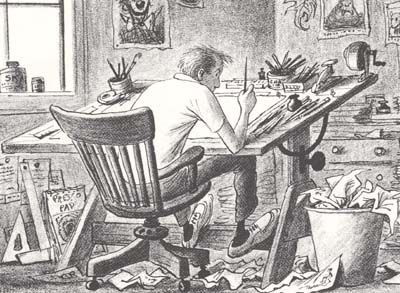In the ’80s, the Altadena Public Library’s children’s section had a whole shelf of his books. I don’t know if I read all of them in those long-ago days, but I read his books long after Jacqui, the head librarian, thought I should stop reading picture books. (I liked her quite a lot, but she did tend to take reading level seriously that way and wanted me to stretch myself.) I really ought to acquire some for my own kids; they’re funny and clever, and his art style was so distinctive that I’m surprised it took me as long as it did for it to fully click that, yes, his design was all through mid-century Disney animation.
Bill Peet was an artist to his marrow bones. As a child, he drew when he was supposed to be doing, well, literally anything else. He got in trouble in school for it, until he started simply taking art classes. Lots of art classes. Eventually, he sent drawings to Disney, who was in the middle of gearing up for Snow White and the Seven Dwarfs. Walt ran a one-month trial program; the three who succeeded out of Peet’s group of fifteen became in-betweeners, and Peet went to work on Donald Duck cartoons.
For those unaware, an in-betweener is an animator. The director draws a certain number of frames per second—say, frames 1, 5, 9, 14, and 19—and the in-betweener does the ones in between, making the movement between the lead animator’s frames smooth enough to fool the eye. Day after day, Peet was drawing frames with very, very small differences; one day, he snapped and screamed, “No more ducks!” And went running out of the building. The next day, rather embarrassed, he returned for his jacket. And discovered a note on his desk telling him that he was promoted to the story department.
Peet had a difficult relationship with Walt; reading between the lines, it seems that Walt reminded him of a successful version of Peet’s own father—a man of big ideas and not many people skills. You got along with Walt Walt’s way, and if you didn’t, you didn’t get along with Walt. But Peet’s autobiography also includes several poignant stories of the moments where he and Walt connected, including a time Walt told Peet some truly horrific childhood stories; Elias Disney was a piece of work, too. Still, it’s no wonder that Peet eventually left the studio to do his own work.
Only one person in history has storyboarded an entire Disney film, and he did it twice. Maybe he doesn’t have quite the vibrant Disney legacy of Mary Blair, but his touch is still visible if you know what to look for. And as a small, bookish child, I spent a lot of time looking into Peet’s art style. Also his gift for sly humour. Unlike a lot of other children’s books, especially from the era when he started writing, his books were funny. I loved his books then; I love them now. I wouldn’t even say my appreciation for him is deeper than it was in the ’80s, just wider.
Help me afford some more of Peet’s books; consider supporting my Patreon or Ko-fi!

